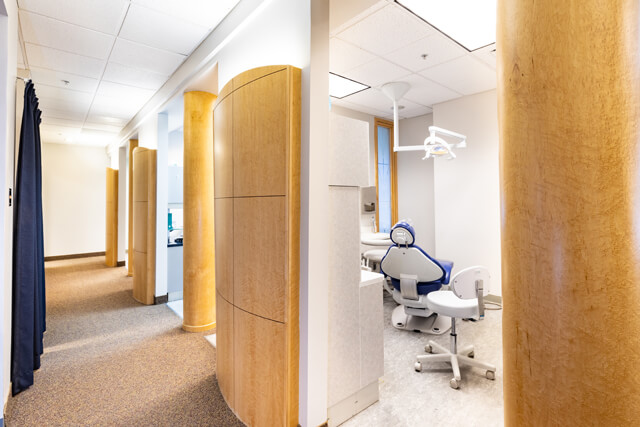Periodontal Scaling and Root Planing

Focus: Learn why this treatment is used to treat gum disease and how it can benefit your oral health.
Scaling and root planing is a deep cleaning procedure used to treat gum disease, also known as periodontal disease.
It involves the removal of plaque and tartar buildup from the teeth and smoothing of the tooth roots to remove bacteria and promote healing.
Key Takeaway
Gum disease (periodontal disease) is a serious oral health condition that can have negative effects on your overall health. Periodontal scaling and root planing are effective treatments that prevent the progression of gum disease and improve your oral and overall well-being.
The Connection Between Gum Disease and Overall Health
Gum disease, or periodontal disease, is more than just an oral health issue; it is intricately connected to overall health.
Research has shown that the inflammation and bacteria associated with gum disease can enter the bloodstream, potentially leading to or exacerbating systemic conditions.
Individuals with untreated periodontal disease may have an increased risk of cardiovascular diseases, such as heart attack and stroke, due to the inflammatory response and potential impact on arteries.
Individuals with diabetes also have a higher risk of developing gum disease, and uncontrolled periodontal disease can make it more challenging to manage blood sugar levels.
Pregnant women with gum disease may also be at a higher risk of preterm birth and low birth weight for their babies.
As you can see, treating gum disease is essential not only for maintaining good oral health but also for overall well-being.
Key Takeaway
Untreated gum disease can have negative effects on overall health, including an increased risk of cardiovascular diseases, difficulty managing diabetes, and potential complications during pregnancy.
What is Periodontal Scaling and Root Planing?
Scaling and root planing are both non-surgical procedures that work together to remove plaque, tartar, and bacteria from the teeth and tooth roots.
These treatments are especially important for addressing periodontal pockets, which can form when gum tissue pulls away from the teeth, creating spaces that trap bacteria and debris.
Scaling
Scaling involves using special instruments to remove plaque and tartar from the surfaces of your teeth, including below the gumline.
Plaque is a sticky, colorless film of bacteria that forms on your teeth daily. If not removed, it can harden into tartar, which can irritate your gums and lead to gum disease.
Root Planing
Root planing is the smoothing of the root surfaces to remove any remaining bacteria and promote healing.
Bacteria can hide in the rough, uneven surfaces of the tooth roots and contribute to gum disease. Smoothing these surfaces helps prevent bacteria from recolonizing and reduces inflammation.
Scaling and root planing are often performed together as a comprehensive procedure that effectively combats plaque buildup and periodontal disease progression.
While scaling removes the visible plaque and tartar from the teeth, root planing addresses the bacterial infection beneath the gumline.
Key Takeaway
Scaling and root planing work together to remove plaque, bacteria, and tartar from the teeth and promote healing of the gum tissue. This comprehensive treatment is important for addressing periodontal pockets (gum pockets) and preventing gum disease progression.
Who Needs Periodontal Scaling and Root Planing?
Scaling and root planing are typically recommended when gum disease progresses from gingivitis to periodontitis.
This treatment is especially important when periodontal pockets exceed a depth of 3 millimeters, making it difficult to remove plaque and tartar through regular home care routines.
Dentists or periodontists may also suggest this procedure if there are signs of gum recession or bone loss, which are indications that the condition is advancing.
By addressing these issues early, scaling and root planing can help stabilize the disease, prevent further damage, and facilitate the healing of the gums.
Stages of Gum Disease
Gum disease typically progresses through several stages.
The earliest stage, known as gingivitis, is characterized by red, swollen gums that may bleed during brushing or flossing. At this stage, gum disease is reversible with good dental hygiene and regular cleanings.
If left untreated, gingivitis can advance to periodontitis, where the inner layer of the gum and bone start pulling away from the teeth, forming pockets.
These deep pockets collect debris and can become infected. As periodontitis progresses, the supporting bone and fibers that hold teeth in place can be broken down, leading to tooth mobility or even tooth loss.
Signs of Gum Disease
- Inflamed, red or swollen gums
- Gums that bleed easily, especially during brushing and flossing
- Receding gum line
- Persistent bad breath (perio breath) or taste in the mouth
- Loose teeth
If you experience any of these symptoms, it’s essential to schedule a visit with your dentist for an examination and possible treatment.
Key Takeaway
Periodontal Scaling and root planing are typically recommended for individuals with advanced gum disease (periodontitis) where periodontal pockets have formed. If left untreated, periodontal disease can lead to serious oral health complications such as tooth loss.
Benefits of Scaling and Root Planing
The primary benefit of scaling and root planing is the effective removal of plaque, bacteria, and tartar from your teeth.
By eliminating these irritants, your gums can heal, which in turn reduces inflammation and promotes a healthier mouth.
Other benefits include:
- Prevents disease progression: Scaling and root planing prevents gum disease from advancing to more severe stages, which can lead to tooth and bone loss.
- Improved oral health: By removing bacteria and promoting healing, scaling and root planing can help stabilize your oral health and reduce the risk of future issues.
- Better overall well-being: As mentioned earlier, treating gum disease is vital for maintaining good overall health. Scaling and root planing can help lower the risk of systemic conditions linked to periodontal disease.
Scaling and Root Planing Procedure
The procedure begins with a comprehensive evaluation of the patient’s periodontal health.
Dr. Font and Dr. Norouzinia assess the depth of periodontal pockets and the extent of plaque and tartar buildup using advanced diagnostic tools.
- Upon completing the assessment, local anesthesia is administered for patient comfort.
- The treatment area is numbed.
- Manual and ultrasonic scalers are used to remove plaque and tartar above and below the gumline (scaling).
- Rough or uneven surfaces on the tooth roots are smoothed out (root planing) to discourage bacteria from recolonizing.
The duration of the procedure depends on the severity and extent of gum disease and can range from one to two appointments.
Post-Procedure Care
Following scaling and root planing, patients will receive specific post-procedure instructions from their periodontist, including:
- Avoid eating or drinking hot foods or beverages until numbness wears off.
- Be mindful of possible teeth sensitivity and avoid extremely cold or hot foods until your teeth adjust.
- Take over-the-counter pain relievers as needed to manage discomfort.
- Avoid eating hard or sticky foods for the first few days after treatment.
- Use the prescribed mouth rinse to help control bacteria and inflammation in the treated area.
- Continue brushing twice a day with a soft-bristled toothbrush and flossing daily to maintain good oral hygiene and prevent further plaque buildup.
- Eat a balanced diet to support healing.
- Attend all follow-up appointments with your periodontist or dentist.
Periodontal maintenance appointments may also be recommended every three to four months for ongoing monitoring and professional cleanings.
Importance of Periodontal Maintenance
Regular periodontal maintenance is essential for long-term gum health following scaling and root planing procedures.
These appointments play a critical role in monitoring gum health, cleaning hard-to-reach areas, and ensuring that the disease does not progress further.
| Frequency | Procedure | Purpose |
|---|---|---|
| Periodontal maintenance every 3-4 Months | Periodontal check-up | Assess gum health and monitor pocket depth |
| As Needed | Further scaling and root planing | Remove plaque and tartar to prevent buildup |
| Annually | Comprehensive evaluation | Evaluate overall oral health and detect any changes early |
By adhering to the recommended periodontal maintenance schedule, patients can significantly reduce the risk of future periodontal problems and maintain a healthy, confident smile.
The Role of a Periodontist in Scaling and Root Planing
Periodontists are dental specialists specifically trained in diagnosing, preventing, and treating gum disease.
Their extensive education and clinical experience focus on the soft and hard tissues of the mouth, providing them with a deep understanding of periodontal disease and its impact on overall oral health.
They receive specialized training in advanced treatment techniques and state-of-the-art technology to accurately assess the severity of gum disease and determine the most effective treatment plan tailored to each patient’s needs.
This expertise ensures that the procedures they perform effectively address existing gum disease and contribute to long-term oral health maintenance.
Get To Know Our Doctors
Dr. Bahman (Mike) Norouzinia, DDS, is a skilled periodontist known for his strong patient relationships.
He earned his Doctorate in Dental Surgery from the University of Texas Health Science Center in 2011. He completed a two-and-a-half-year residency at the University of Missouri-Kansas City, obtaining a specialty certificate in Periodontics and a Master of Science in Oral and Craniofacial Sciences.
Dr. Norouzinia is a board-certified periodontist and holds the title of Diplomate of the American Board of Periodontology.
Dr. Kerri Font, DDS, is an accomplished periodontist with a distinguished academic and professional background.
She earned her dental degree from the University of the Pacific, Arthur A. Dugoni School of Dentistry. She received the Student Award in Periodontology and was inducted into the TKO and OKU honor societies.
She completed her specialty training in Periodontology at Wilford Hall Medical Center in 2005 and achieved Diplomate status in The American Academy of Periodontology in 2006, along with a Master of Science in Periodontology from The University of Texas Health Science Center at San Antonio.
Schedule a Consultation
If you are experiencing symptoms of gum disease or have been referred for scaling and root planing by your dentist, schedule a consultation with our experienced periodontists.
Call (303) 683-1144 to book an appointment at our periodontal clinic in Highlands Ranch, or complete the online booking form.
We are committed to helping you keep your teeth and gums healthy!
FAQs About Periodontal Scaling and Root Planing
Patients report minimal pain during the procedure due to the use of local anesthesia. Some tenderness and sensitivity may be experienced after treatment, but this can be managed with over-the-counter pain relievers.
Many dental insurance plans cover scaling and root planing as a necessary periodontal treatment. It is best to check with your specific insurance provider for coverage details.
As with any dental procedure, there are some potential risks involved, such as infection or temporary tooth sensitivity. However, these risks are minimal and can be minimized by following post-procedure instructions provided by your periodontist.
Complete recovery can take a few days to a few weeks, depending on the individual and the severity of gum disease.
Gum disease can be caused by a variety of factors, including poor oral hygiene, genetics, certain medications, and hormonal changes. Medical conditions such as diabetes and autoimmune disorders may also increase the risk of developing gum disease. It is important to inform your dentist of any medical conditions you have so that they can monitor your oral health more closely.


